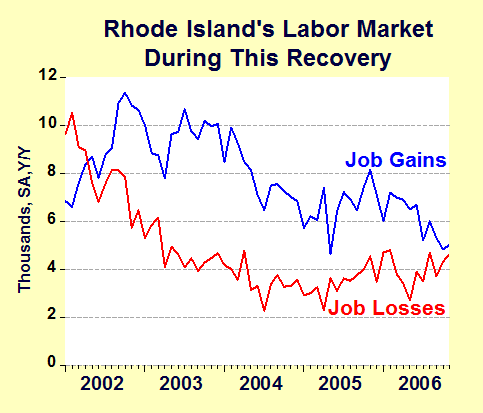|
|
RI EMPLOYMENT DATA
TRICKY TO ANALYZE
The Providence Journal, Money & Business Section
January 2007
Judging by the economic statistics being
publicized in the media, anyone who has attempted to find a job lately
should have encountered improving job prospects. Employment has been
rising while the unemployment rate has been falling. In fact, the
national unemployment rate is currently at a level deemed to be close to
or at full employment, while Rhode Island’s current jobless rate is
substantially lower than its value just a few months ago.
Focusing on Rhode Island, though, it is likely that a fairly large
number of job seekers would disagree with the characterization of the
labor market given by these statistics. Both layoffs and long-term
unemployment here have been trending upward in recent months. Not only
have the monthly numbers for payroll employment change continued to
diminish, November’s value was actually zero!
Fortunately, the monthly employment change, which is the “headline”
number each month, does not indicate the number of jobs added for the
most recent month. Instead, it reflects something entirely different:
the divergence between job gains and job losses for that month. So, the
good news is that Rhode Island is adding more jobs than is widely
perceived. The bad news is that there is more job loss occurring than
many are aware of. Perhaps more importantly, these one-month changes are
seldom statistically significant, which results in their frequent
revision, often making today’s headlines prove to be incorrect.
Instead of focusing on one-month changes, it is preferable and more
accurate to view employment change compared to the same month one year
ago. This is called the year-over-year change. The direction of
year-over-year change is seldom revised, although this sometimes occurs
since the most recently released employment value is an extrapolation
beyond the time period of known data. Focusing on year-over-year change,
our state has fluctuated nationally between #47 and #49 for the last
five months, with a rank of #48 for November. The graph (below) of
year-over-year values for jobs added and job losses during this recovery
paints a very troubling picture: the two lines are converging. Rhode
Island’s overall employment has continued to shrink as both the national
and Rhode Island economies have slowed.

Perhaps things aren’t as grim as this graph
makes them appear. In order to delve more deeply into the possibility
that this might be one of those infrequent periods where currently
released employment data are understating employment, I performed an
econometric analysis of Rhode Island’s payroll employment data
conditional on a set of non-survey-based variables. The results suggest
the possibility that the currently released payroll employment value for
November is understating the correct value which will be released with
“rebenchmarking” next month. If this econometric analysis proves to be
correct, actual payroll employment here could be as much as 2,000 higher
than the levels that are now being reported. While this might not seem
like a very large difference, for Rhode Island this could prove to be
significant, especially as the pace of economic activity at both the
national and state levels continues to slow.
So, employment data can be tricky to understand and analyze. Rhode
Island may be in one of those infrequent time periods where currently
reported employment data are understating actual values. We will have to
wait until next month to see if this is correct.
by Leonard Lardaro |

